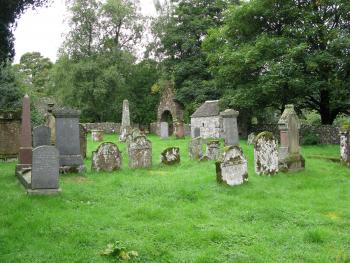- Navigation:
- Back to the Corpus index page
- RSS
Kilmahog / Kilmahug Parish Church
Kilmahog Churchyard 1
- Dedication: St Machutus
- Diocese of Dunblane
- County of Perthshire
- Stirling Council
- NN 6090 0827
Summary description
Nothing survives above ground of the medieval parish church, which stood in a churchyard on the north bank of the River Teith.
Historical outline
Dedication: St Machutus
The dedication of the church points towards an early origin but the first surviving record of it dates from 1259, when provision was made for the annexation of the parsonage to the episcopal mensa of Dunblane.(1) The annexation was to occur on the death of the incumbent parson. This annexation does not seem to have occurred before 1274-5, the church still appearing as a free parsonage in Bagimond’s Roll.(2) The cure thereafter was served by a vicar perpetual, the parsonage remaining annexed to the episcopal mensa in 1561/2.(3)
In February 1538/9, Thomas Muschet received the lands of ‘Garyndewyr, lyand besyd Cultintogill…with the bell and all fredomes, privileges and pertinentis pertenyng tharto’.(4) These properties had fallen into the hands of the crown through nonentry of heirs following the death of one Finlay Dewar. In 1572, one Donald Dewar was confirmed in possession of the 40d land of Garrindewar in the lordship of Strathgartney. Possession of this property thus seems to have been linked to the office of deoradh, the medieval Gaelic term for the person who had custody of the relics of a saint.(5) By the late medieval period, the duties of the deoradh seem to have been limited to ringing a bell ‘in the presence of the dead’, probably a handbell associated with the saint rung at funerals. This office was abolished as a relic of ‘papistry’ at the Reformation and the lands had accordingly devolved to the crown, but were restored to the hereditary deorach.(6)
In 1669, it was recorded that there had formerly been a fair held annually on 15 November (St Machutus’s feast day) at the church of Kilmahug.(7) The fair had apparently not been held at Kilmahug but at Doune since the 1630s, and from 1669 it was formally transferred to Doune as one of the four annual fairs of the burgh of barony of Doune.
Notes
3. RMS, ii, no 763; Kirk (ed.), Book of Assumptions, 295, 348.
5. Black, Surnames of Scotland, 207.
Architectural description
The church, locally known as the Chapel of St Chug, was located within a churchyard on the north bank of the River Teith. Its presumed site within the churchyard is marked by a metal plate, though it is not known if the placing of that plate is based on firm evidence. An element of confusion has been introduced by the construction of a large-scale arched entrance to the churchyard, with a recess for a bell near the apex of the gable that surmounts it. This has been interpreted by some as a gable of the church, which it clearly is not.
Bibliography
Black, G.F., 1946, The surnames of Scotland, New York, 207.
Calendar of entries in the Papal registers relating to Great Britain and Ireland; Papal letters, 1893-, ed. W.H. Bliss, London, i, 367.
Cowan, I.B., 1967, The parishes of medieval Scotland, (Scottish Record Society), Edinburgh, 103.
Dunlop, A.I., 1939, ‘Bagimond’s Roll, statement of the tenths of the kingdom of Scotland’ Miscellany of the Scottish History Society, vi, 1-77, at 54.
Gifford, J. and Walker, F.A., 2002, The Buildings of Scotland, Stirling and Central Scotland, New Haven and London, 555.
Kirk, J., 1995, The books of assumption of the thirds of benefices, (British Academy) Oxford, 295, 348.
Records of the Parliaments of Scotland, ed. K. Brown et al.( digital editions of the acts of the pre-1707 Scottish Parliament, based at the University of St Andrews), 1669/10/151.
Registrum Magni Sigilli Regum Scotorum, 1882, ii (1424-1513), Edinburgh, no 763.
Registrum Secreti Sigilli Regum Scotorum, 1908-82, ed. J.M. Thomson et al., Edinburgh, ii, no 2898 and n. 3.
Royal Commission on the Ancient and Historical Monuments of Scotland, Canmore database.
Map
Images
Click on any thumbnail to open the image gallery and slideshow.







